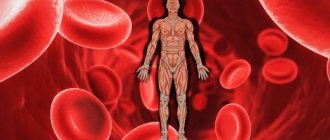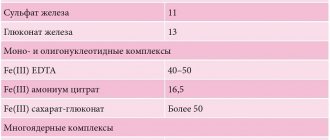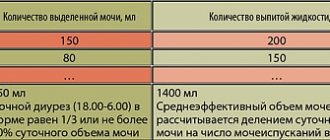What is folate deficiency anemia? Its causes and risk factors for developing the disease
Folate deficiency anemia is a type of anemia (anemia) caused by a lack of folic acid, which is also called vitamin B9.
It is necessary for the formation of new cells. First of all, with a lack of folic acid, the rate of formation of red blood cells (erythrocytes) decreases and anemia develops as a result of a lack of hemoglobin. The main causes of vitamin B9 deficiency:
- insufficient dietary intake of folic acid. There is a lot of it in broccoli, Brussels sprouts, peas, chickpeas, brown rice, artichokes. Most often, those who abuse alcohol suffer from B9 deficiency;
- malabsorption - impaired absorption of nutrients. This phenomenon is mainly observed in intestinal diseases;
- diseases associated with frequent urination (for example, chronic heart failure);
- taking medications that reduce the amount of folic acid or make it difficult to absorb. These include anticonvulsants;
- increased need for vitamins. Pregnancy, cancer, some hematopoietic disorders (for example, sickle cell anemia), infections are conditions that increase the body's need for folic acid. Premature babies (born before the 37th week of pregnancy) also need more of it.
Folate deficiency anemia
Iron deficiency
25682 October 28
IMPORTANT!
The information in this section cannot be used for self-diagnosis and self-treatment.
In case of pain or other exacerbation of the disease, diagnostic tests should be prescribed only by the attending physician. To make a diagnosis and properly prescribe treatment, you should contact your doctor. Folate deficiency anemia: causes, symptoms, diagnosis and treatment methods.
Definition
Anemia caused by folic acid deficiency, also called vitamin B9, is a blood disease characterized by a decrease in the amount of hemoglobin and red blood cells (red blood cells).
Folic acid is a natural vitamin that is necessary for normal hematopoiesis.
Under normal conditions, it is synthesized by the intestinal microflora and enters the body as part of folate with food of plant origin (legumes, wholemeal flour, asparagus, spinach, lettuce, broccoli, beef liver).
In the body, folic acid is present in the form of its coenzyme form - tetrahydrofolic acid, which is actively involved in the synthesis of glutamic acid, pyrimidine and purine bases, as well as thymidine monophosphate - a component of DNA. With folate deficiency anemia, first of all, the synthesis of nucleic acids of actively dividing hematopoietic cells is disrupted, resulting in the development of anemia, often combined with leukopenia and thrombocytopenia.
Causes of folate deficiency anemia
The development of folate deficiency anemia is based on many different causes and risk factors. The supply of folic acid in the body is insignificant, so it must be constantly replenished.
One of the main reasons for the development of vitamin B9 deficiency is its insufficient dietary intake.
Often the problem of lack of folic acid in the body is observed in people who abuse alcohol and psychotropic substances. People who consume little vegetables and fruits, especially older people, are also at risk of developing vitamin B9 deficiency.
Folic acid is involved in the process of cell division and is required in large quantities for their growth and rapid renewal.
In this regard, a common cause of folate deficiency anemia is an excessive need for folic acid with low dietary intake. The risk group includes women during pregnancy and lactation, children during periods of intensive growth, and adolescents. People suffering from chronic skin diseases, such as psoriasis and eczema, also need a large amount of folic acid.
Hemolytic anemia (in which, for various reasons, increased destruction of red blood cells occurs) of various origins also contributes to the development of folic acid deficiency.
Malabsorption of folic acid occurs in various intestinal diseases, which are characterized by malabsorption syndrome (decreased function of nutrient absorption in the intestine).
These include inflammatory bowel diseases (for example, Crohn's disease), celiac disease (celiac disease), food allergies in children with intestinal manifestations, lactase deficiency.
In children, the following risk factors play a significant role in the development of folate deficiency anemia: prematurity, low birth weight (less than 2500 g), feeding with whole goat milk, use of unadapted milk formulas, frequent infectious and inflammatory diseases, including the gastrointestinal tract. Various enteritis (inflammation of the small intestine) pose a particular danger of developing anemia in young children.
Medicines and toxic substances can disrupt the absorption and metabolism of folic acid in the body.
Some drugs (for example, methotrexate, used to treat cancer, psoriasis, rheumatoid arthritis, etc.) are folic acid antagonists. Anticonvulsant medications can also lead to folic acid deficiency in the body.
Rare causes of the development of folate deficiency anemia include hereditary defects in folic acid metabolism associated with insufficiency of enzyme systems.
Classification of folate deficiency anemia
There is no generally accepted classification of folate deficiency anemia. However, any anemia is divided into degrees of severity depending on the level of decrease in blood hemoglobin. For children over 6 years of age and adults the following classification applies:
- mild anemia: hemoglobin level from 90 to 120 g/l;
- moderate anemia: hemoglobin level from 70 to 89 g/l;
- severe anemia: hemoglobin level below 70 g/l.
For children under 6 years of age, the normal hemoglobin level is above 110 g/l.
According to ICD-10
The following types of folate deficiency anemia are distinguished:
- Diet-related folate deficiency anemia.
- Folate deficiency anemia is drug-induced.
- Other folate deficiency anemias.
- Folate deficiency anemia, unspecified.
Symptoms of folate deficiency anemia
With folate deficiency anemia, pallor of the skin and mucous membranes with a slight icteric tint, general weakness and decreased performance are noted. Characterized by rapid fatigue and irritability. Due to a decrease in oxygen delivery to tissues, shortness of breath occurs, heart rate increases, and blood pressure may decrease. Patients complain of poor appetite, ringing in the ears and flashing “spots” before the eyes. In severe cases, fainting is possible.
When examining blood, a decrease in the amount of hemoglobin and red blood cells is noted, the color indices of the blood increase (showing an increase in the saturation of red blood cells with hemoglobin), as well as the size of red blood cells. An increase in the content of indirect bilirubin in the blood serum is associated with the destruction of “wrong” red blood cells that are too large. Often, folate deficiency anemia is combined with B12 deficiency anemia, in which various neurological disorders develop, and also accompanies iron deficiency anemia.
For infants and young children, additional symptoms of the development of folate deficiency anemia are lethargy or increased excitability, which develop due to a decrease in oxygen delivery to brain tissue.
Diagnosis of folate deficiency anemia
It is necessary to diagnose folate deficiency anemia before starting treatment, since folic acid deficiency is often combined with iron deficiency, vitamin B12 and protein deficiency. The plan for the necessary laboratory and instrumental examinations includes the following tests:
- level of folic acid in the blood;
Symptoms and signs of folate deficiency anemia
A decrease in the number of red blood cells leads to the inability to adequately supply cells with oxygen: the mucous membranes and skin turn pale, a person quickly gets tired, feels weak, fainting, dizziness, loss of appetite and weight loss are possible. To compensate for the lack of oxygen, the heart beats faster to pump blood faster; breathing accelerates. Palpitations become palpable and shortness of breath appears. Folate deficiency anemia may be accompanied by diarrhea, loss of taste, numbness in the limbs, muscle weakness and depression.
Causes of B12 deficiency anemia
A lack of vitamin B12 may be due to the following reasons or a combination of them:
- impaired absorption of the vitamin in the intestine: gastritis associated with Helicobacter pylori infection, Crohn's disease, previous intestinal surgeries, polyposis of the gastric mucosa, cancer, intestinal fistulas, etc.;
- congenital metabolic disorders;
- chronic intoxication with nitric oxide, used as sedation in anesthesiology.
- minor absorption disorders, for example, a decrease in the availability of B12 in food with chronic pancreatitis, moderate atrophic gastritis, taking metformin, medications to reduce the production of hydrochloric acid, etc.;
- poor diet, vegetarianism;
- chronic alcoholism.
One form of B12 deficiency anemia is Addison-Biermer disease. With it, autoantibodies appear against the cells of the gastric mucosa.
It is worth noting that B12 and folate deficiency anemias are closely related. Folic acid (vitamin B9) also takes part in the formation of red blood cells. Even a full supply of these components in food does not guarantee the absence of anemia in cases where there is an increased consumption or there is a violation of utilization in the bone marrow. This may be due to parasitosis, intestinal dysbiosis, pregnancy, liver and blood diseases.
Diagnostic methods
A doctor may suspect anemia based on symptoms and the results of a complete blood count, which will show a low number of red blood cells. To confirm the diagnosis, it is necessary to test the blood for folic acid and vitamin B12, the deficiency of which often accompanies B9 deficiency.
It is not enough to diagnose a disease; it is important to establish its cause. After all, the further treatment strategy will depend on this. It is necessary to study medical histories (are poor nutrition, alcoholism, pregnancy possible?) and examine the patient for pathologies of the intestines, liver, and heart.
Diagnostic features
Treatment of B12-deficiency anemia is prescribed after a comprehensive examination. The doctor will order the following laboratory hematological and other tests:
- general blood analysis;
- biochemical and immunological studies: determination of the level of B12 in plasma, assessment of the level of homocysteine in serum or blood plasma, determination of antibodies to gastric parietal cells, etc.;
- bone marrow aspiration or trephine biopsy.
Gastroscopy may also be required to detect atrophic gastritis.
The diagnosis is made by a doctor based on complaints, manifestations of the disease, and laboratory test parameters. It is important to find out the cause of the syndrome, especially to detect Addison-Biermer disease.
In addition, a specialist needs to distinguish this type of anemia from other diseases accompanied by disturbances in hematopoietic processes. Thus, if liver cirrhosis is suspected, disorders associated with long-term use of certain drugs (sulfonamides, anticonvulsants), sideroblastic anemia will require differential diagnosis.
Treatment
They start with prescribing folic acid supplements. For pregnant women, this is most often the only purpose. In other cases, the treatment regimen is drawn up taking into account the causes of the disease. If you have an unbalanced diet, you need to review your diet and include foods rich in vitamin B9. Quitting alcohol abuse is also an important step in the fight against folate deficiency anemia.
Problems with internal organs require specific treatment, depending on the type of disease.
If the level of vitamin B12 in the blood is low, the patient is prescribed injections or tablets. This is very important because normalizing folic acid levels can mask the symptoms of B12 deficiency, which can cause nervous system dysfunction.
Complications of the disease
The course of folate deficiency anemia can be complicated by:
- pernicious (pernicious) anemia caused by a lack of vitamin B12;
- leukopenia (decreased number of white blood cells);
- thrombocytopenia (decreased platelet count);
- stomatitis;
- glossitis (inflammation of the tongue);
- nausea and vomiting;
- diarrhea;
- slight increase in body temperature;
- decreased immunity.
Folate deficiency anemia and pregnancy
Lack of folic acid during pregnancy is very dangerous. It can lead to abnormal development of the fetus's neural tube, the structure from which the brain and spinal cord are formed. These changes can cause miscarriage, death of the newborn, or paralysis of his legs. The detrimental effect of folic acid deficiency can affect the development of the embryo in the first weeks after conception. Therefore, expectant mothers are recommended to take folic acid supplements at the stage of pregnancy planning.








